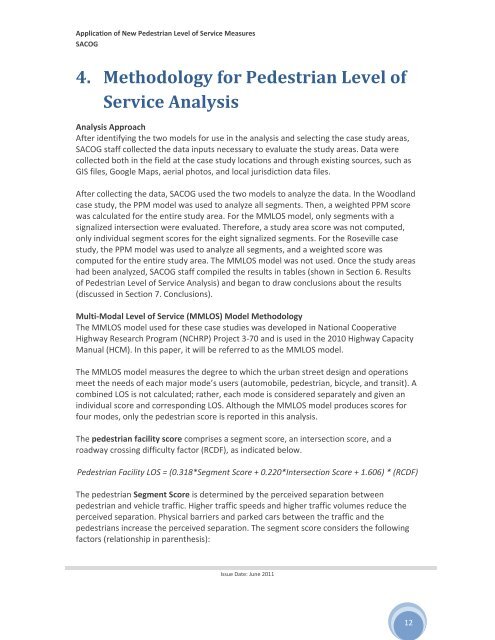Application of New Pedestrian Level of Service Measures - sacog
Application of New Pedestrian Level of Service Measures - sacog
Application of New Pedestrian Level of Service Measures - sacog
Create successful ePaper yourself
Turn your PDF publications into a flip-book with our unique Google optimized e-Paper software.
<strong>Application</strong> <strong>of</strong> <strong>New</strong> <strong>Pedestrian</strong> <strong>Level</strong> <strong>of</strong> <strong>Service</strong> <strong>Measures</strong><br />
SACOG<br />
4. Methodology for <strong>Pedestrian</strong> <strong>Level</strong> <strong>of</strong><br />
<strong>Service</strong> Analysis<br />
Analysis Approach<br />
After identifying the two models for use in the analysis and selecting the case study areas,<br />
SACOG staff collected the data inputs necessary to evaluate the study areas. Data were<br />
collected both in the field at the case study locations and through existing sources, such as<br />
GIS files, Google Maps, aerial photos, and local jurisdiction data files.<br />
After collecting the data, SACOG used the two models to analyze the data. In the Woodland<br />
case study, the PPM model was used to analyze all segments. Then, a weighted PPM score<br />
was calculated for the entire study area. For the MMLOS model, only segments with a<br />
signalized intersection were evaluated. Therefore, a study area score was not computed,<br />
only individual segment scores for the eight signalized segments. For the Roseville case<br />
study, the PPM model was used to analyze all segments, and a weighted score was<br />
computed for the entire study area. The MMLOS model was not used. Once the study areas<br />
had been analyzed, SACOG staff compiled the results in tables (shown in Section 6. Results<br />
<strong>of</strong> <strong>Pedestrian</strong> <strong>Level</strong> <strong>of</strong> <strong>Service</strong> Analysis) and began to draw conclusions about the results<br />
(discussed in Section 7. Conclusions).<br />
Multi‐Modal <strong>Level</strong> <strong>of</strong> <strong>Service</strong> (MMLOS) Model Methodology<br />
The MMLOS model used for these case studies was developed in National Cooperative<br />
Highway Research Program (NCHRP) Project 3‐70 and is used in the 2010 Highway Capacity<br />
Manual (HCM). In this paper, it will be referred to as the MMLOS model.<br />
The MMLOS model measures the degree to which the urban street design and operations<br />
meet the needs <strong>of</strong> each major mode’s users (automobile, pedestrian, bicycle, and transit). A<br />
combined LOS is not calculated; rather, each mode is considered separately and given an<br />
individual score and corresponding LOS. Although the MMLOS model produces scores for<br />
four modes, only the pedestrian score is reported in this analysis.<br />
The pedestrian facility score comprises a segment score, an intersection score, and a<br />
roadway crossing difficulty factor (RCDF), as indicated below.<br />
<strong>Pedestrian</strong> Facility LOS = (0.318*Segment Score + 0.220*Intersection Score + 1.606) * (RCDF)<br />
The pedestrian Segment Score is determined by the perceived separation between<br />
pedestrian and vehicle traffic. Higher traffic speeds and higher traffic volumes reduce the<br />
perceived separation. Physical barriers and parked cars between the traffic and the<br />
pedestrians increase the perceived separation. The segment score considers the following<br />
factors (relationship in parenthesis):<br />
Issue Date: June 2011<br />
12
















